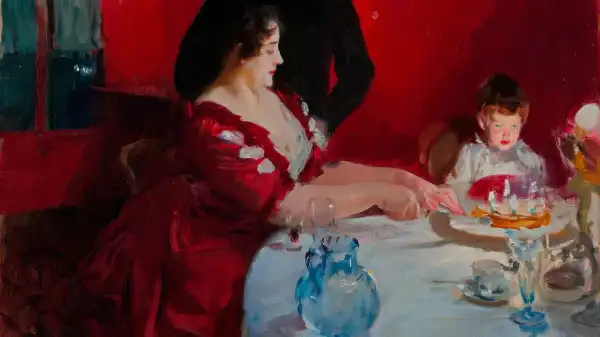
Save this storySave this storySave this storySave this storyYou're reading the Goings On newsletter, a guide to what we're watching, listening to and doing this week. Sign up to get it sent to your inbox.
Summer is a time of scandal; people tend to overheat and lose their incentives, trying to cloud their clear minds with idle gossip. Minor controversies can escalate, given the right temperature, into entanglements; such was the case in Paris in 1884, when the twenty-eight-year-old artist John Singer Sargent presented a new large-scale portrait at the Salon, then the most important summer art exhibition in the world. Sargent had every reason to feel confident heading into the Salon; ever since he arrived in Paris at eighteen (from Italy, where he was born to American parents) to study at the École des Beaux-Arts, he had been on an ambitious path to becoming one of the city’s most sought-after portrait painters.

“Birthday”, 1885.
Art by John Singer Sargent / Courtesy of the Minneapolis Institute of Arts
Sargent’s early work had a more impressionistic bent—as a student, he traveled to Spain and Morocco, painting mystics, courtyards, and beach scenes—but he honed his professional niche painting portraits of Belle Époque aristocrats, who found Sargent’s sumptuous style (rich, saturated colors, vivid lighting, meticulous attention to small details like fingertips and the texture of fabrics) deeply appealing. Sargent was known for making women beautiful, so it’s no surprise that over the years he actively sought out Paris’s most famous beauty to pose for him. Virginie Amélie Avegno Gautreau, then Paris’s leading It Girl, was, like Sargent, an American immigrant (born in New Orleans and moved to Paris at age eight); she married a wealthy man and became famous in high society for her athletic nature and striking looks. (She had a distinctive Roman nose, thick reddish hair, a penchant for heavy makeup, and a complexion so pale it was almost translucent.) Sargent hoped his portrait of Gautreau (the painting now known as Madame X) would be a sensation at the Salon—and it was, but not in the way he had hoped. The public did not take to it. They thought Gautreau looked sickly, bored, and awkward. Sargent painted Gautreau in profile, to emphasize her regal bone structure; the crowd thought it made her look shy and snotty. He painted one strap of her dress slipping off her shoulder, which critics found indecent. (Sargent later had the strap fixed.) The press raged about the fiasco all summer until Sargent fled Paris for London.
In 1915, Gautreau died at age fifty-six, never having recovered from her “Madame X” summer. She was so embarrassed by her image that she removed all the mirrors from her home. The following year, Sargent sold “Madame X” to the Metropolitan Museum of Art, along with a note calling it “the best thing I have ever done.” The painting has since become a crown jewel of the Met's collection—the winds of time have changed its reputation from infamy to masterpiece—and it is now the focus of a new Met exhibition , “Sargent and Paris” (through Aug. 3), which explores Sardes's short, industrious decade.
Sourse: newyorker.com






